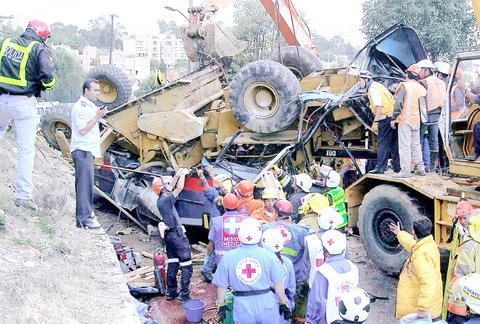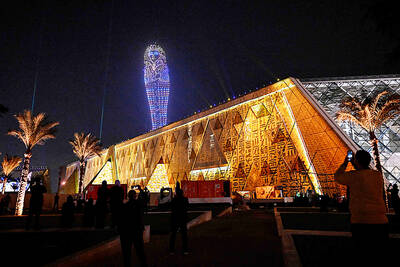A construction crew's backhoe tumbled down a hillside onto a school bus on the highway below, killing 21 children and two adults and injuring 36 others, officials said.
The 45-tonne earth mover was being driven along a section of road higher up the hill when it rolled off a ledge and plunged about 20m before crushing the bus on the highway below, said Claudia Cubillos, a spokeswoman for the Bogota Health Ministry, which oversees rescue efforts.
The bus was taking 7- to 12-year-old students from Agustiniano School home in the capital's middle-class Suba district during the Wednesday afternoon rush hour. Traffic behind the wreck was backed up for several kilometers.

PHOTO: EPA
About a hundred emergency workers and police used heavy machinery to try to clear the mangled wreckage and get to the children trapped inside.
Police struggled to hold back families desperate to find out if their children were among the victims.
Laura Ortiz, a travel monitor at the school, said she was supposed to have ridden the bus but asked a friend to fill in because she got tied up in a meeting. She fears that her son was on board.
``I am looking for my son ... I don't know where he is right now,'' a tearful Ortiz told RCN television.
Mayor Luis Eduardo Garzon sped to the scene of the accident by motorbike to show solidarity with the victims and their families.
``It is profoundly painful. We are united behind the families and have asked the attorney general's office to fully explain the causes of the accident,'' Garzon told reporters.
Police spokesman Sargent Alberto Cantillo said it was not immediately clear whether the two adult victims were traveling inside the bus. The bus driver survived unharmed, while the backhoe's driver was in critical condition.
Preliminary findings indicated the backhoe's brakes failed and the driver lost control of the vehicle, Cantillo said. He declined further comment pending the results of an investigation.
It was the deadliest road accident in the capital's history. In 1997, 18 people were killed in a bus collision.
On average, nearly 700 people die every year in traffic accidents in Bogota, though more than half of them are pedestrians.

‘CHILD PORNOGRAPHY’: The doll on Shein’s Web site measure about 80cm in height, and it was holding a teddy bear in a photo published by a daily newspaper France’s anti-fraud unit on Saturday said it had reported Asian e-commerce giant Shein (希音) for selling what it described as “sex dolls with a childlike appearance.” The French Directorate General for Competition, Consumer Affairs and Fraud Control (DGCCRF) said in a statement that the “description and categorization” of the items on Shein’s Web site “make it difficult to doubt the child pornography nature of the content.” Shortly after the statement, Shein announced that the dolls in question had been withdrawn from its platform and that it had launched an internal inquiry. On its Web site, Le Parisien daily published a

China’s Shenzhou-20 crewed spacecraft has delayed its return mission to Earth after the vessel was possibly hit by tiny bits of space debris, the country’s human spaceflight agency said yesterday, an unusual situation that could disrupt the operation of the country’s space station Tiangong. An impact analysis and risk assessment are underway, the China Manned Space Agency (CMSA) said in a statement, without providing a new schedule for the return mission, which was originally set to land in northern China yesterday. The delay highlights the danger to space travel posed by increasing amounts of debris, such as discarded launch vehicles or vessel

RUBBER STAMP? The latest legislative session was the most productive in the number of bills passed, but critics attributed it to a lack of dissenting voices On their last day at work, Hong Kong’s lawmakers — the first batch chosen under Beijing’s mantra of “patriots administering Hong Kong” — posed for group pictures, celebrating a job well done after four years of opposition-free politics. However, despite their smiles, about one-third of the Legislative Council will not seek another term in next month’s election, with the self-described non-establishment figure Tik Chi-yuen (狄志遠) being among those bowing out. “It used to be that [the legislature] had the benefit of free expression... Now it is more uniform. There are multiple voices, but they are not diverse enough,” Tik said, comparing it

Prime ministers, presidents and royalty on Saturday descended on Cairo to attend the spectacle-laden inauguration of a sprawling new museum built near the pyramids to house one of the world’s richest collections of antiquities. The inauguration of the Grand Egyptian Museum, or GEM, marks the end of a two-decade construction effort hampered by the Arab Spring uprisings, the COVID-19 pandemic and wars in neighboring countries. “We’ve all dreamed of this project and whether it would really come true,” Egyptian Prime Minister Mostafa Madbouly told a news conference, calling the museum a “gift from Egypt to the whole world from a